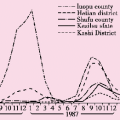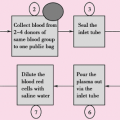Explore Route of Transmission for Kala-azar
Outline
Kala-azar can be transmitted by varied routes in laboratory and experimental animals. But, it can be determined that it is transmitted by bite or sting of the sandflies under natural condition, based on two features of kala-azar epidemiology, i.e., (1) geographic distribution of kala-azar is limited to north of the Yangtze River in China, and wherever there is kala-azar, there are sandflies and no sandflies no kala-azar; and (2) it presents an obvious temporal distribution, each case of infant kala-azar should live for a period of time with breeding of sandflies. Other routes of transmission for kala-azar, including respiratory, digestive and contact routes, can be excluded based on these two features mentioned above, too.
Since the discovery of Leishmania donovani, pathogen of kala-azar (visceral leishmaniasis) in 1903, studies on how it can be transmitted had been done by many health-care workers. At the early stage of the studies, most researchers attempted to solve this issue form laboratory animals and the patients with kala-azar, which resulted in making a few detours in their efforts, except for individual worker such as Sinton [1], who studied from epidemiological perspectives and took notice of consistency between the distribution of patients with kala-azar and distribution of sandflies in India. Forkner and Zia [2] emphasized that kala-azar must be transmitted directly from human to human under natural environment without any intermediate vectors only based on the specific phenomena that L. donovani was detected from the throat of one patient of kala-azar. Similarly, other researchers (Critien 1910, Mackie 1914, Shortt, et al. 1929) [2] in India also discovered Leishmania occasionally in their feces of several patients with kala-azar, and believed that it might be transmitted via fecal-oral route as typhoid fever and dysentery. Also, many researchers tried to test if varied insects (e.g., bedbug, fly, sandfly, mosquito, flea, lice, etc.) in laboratory could be the vectors to reproduce L. donovani in their own bodies with different results. But, they all recognized that the sandflies could be the most possible vector because L. donovani could be reproduced in sandflies very easy. Meanwhile, there existed a complicated phenomenon that although L. donovani could be reproduced easily in sandflies, experimental animals could not be infected by bite or sting of sandflies. In contrast, if the experimental animals were fed with L. donovani, they could easily be infected with kala-azar (Archibald 1914, Knowles, et al. 1932, Shortt, et al. 1928, Khow 1930) [2]. Also, as reported by some researchers (Marshall 1911, Sangiorg 1911, Adelheim 1924, Shortt, et al. 1932), normal animals could be infected with kala-azar if they lived with infected animals [2]. All the facts mentioned above indicate that, in laboratory, route of transmission for kala-azar is diversity. Is it also true under natural condition as that in laboratory?
Under natural condition, route of transmission for kala-azar is very clear,
based on the following two phenomena, i.e., kala-azar presents in human population that we can postulate kala-azar must be depend on sandfly as vector to spread under natural condition. Firstly, occurrence of kala-azar presents a significantly geographical characteristics of distribution. It prevails widely over China, including Liaoning, Hebei, Shandong, Henan, Anhui, Hubei, Jiangsu, Shanxi, Shaanxi, Gansu, Qinghai, Xinjiang, Sichuan Provinces, and so on. According to the results of field surveys [3], areas prevalent with kala-azar all locate in north of the Yangtze River. In south of the Yangtze River, there were occasionally a few cases of kala-azar reported, but they all infected in north and fell ill in south. There was occurrence of sporadic case of kala-azar reported in Guangdong Province (Schretzenmayr, et al. 1936) [2] and Fujian Province (Xu 1950) [3], but they were all not confirmed. Obviously, geographical distribution of kala-azar in China is very clear, i.e., with the Yangtze River as a demarcation line, it is prevalent only in north rather than in south of the River. Why is there such a clear demarcation line for the geographical distribution for kala-azar in China?
based on the following two phenomena, i.e., kala-azar presents in human population that we can postulate kala-azar must be depend on sandfly as vector to spread under natural condition. Firstly, occurrence of kala-azar presents a significantly geographical characteristics of distribution. It prevails widely over China, including Liaoning, Hebei, Shandong, Henan, Anhui, Hubei, Jiangsu, Shanxi, Shaanxi, Gansu, Qinghai, Xinjiang, Sichuan Provinces, and so on. According to the results of field surveys [3], areas prevalent with kala-azar all locate in north of the Yangtze River. In south of the Yangtze River, there were occasionally a few cases of kala-azar reported, but they all infected in north and fell ill in south. There was occurrence of sporadic case of kala-azar reported in Guangdong Province (Schretzenmayr, et al. 1936) [2] and Fujian Province (Xu 1950) [3], but they were all not confirmed. Obviously, geographical distribution of kala-azar in China is very clear, i.e., with the Yangtze River as a demarcation line, it is prevalent only in north rather than in south of the River. Why is there such a clear demarcation line for the geographical distribution for kala-azar in China?
Stay updated, free articles. Join our Telegram channel

Full access? Get Clinical Tree







